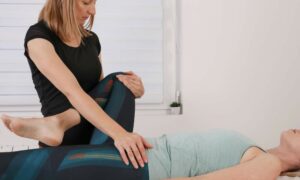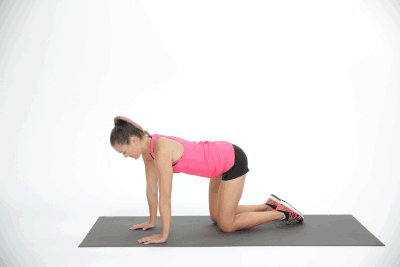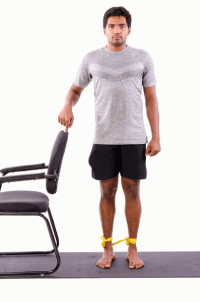Lateral hip pain—a nagging discomfort many of us know all too well. It can disrupt our daily activities, from a simple walk in the park to a peaceful night’s sleep. But what if there was a way to combat this persistent annoyance without delving into complex treatments or endless medical appointments? Good news: there is. Whether you’re searching for some straightforward exercises to soothe the pain or easy-to-adopt treatment options to effectively manage the pain in your lateral hip, you’re in the right place. We’ve compiled top-notch solutions and movements to not only alleviate that troublesome hip pain but to help you regain control of your life. Let’s get started.
Contents
Understanding Lateral Hip Pain
 Lateral hip pain, commonly experienced as discomfort or tenderness on the outer side of the hip, is more than just a simple ache. To truly comprehend its nuances, it’s crucial to start at the basics: the hip’s anatomy.
Lateral hip pain, commonly experienced as discomfort or tenderness on the outer side of the hip, is more than just a simple ache. To truly comprehend its nuances, it’s crucial to start at the basics: the hip’s anatomy.
Now, when it comes to lateral hip pain, the culprits are often linked to strains, overuse, injuries, or inflammation of these components. One of the most commonly associated conditions is trochanteric bursitis. This involves the inflammation of the bursa located at the bony point of the hip, leading to pain, especially during activities like walking or lying on the affected side.
Understanding the anatomy and underlying causes is the first step in effectively addressing and treating lateral hip pain. With this foundation, we can now delve deeper into targeted solutions and exercises that promise relief.
Home Remedies and Natural Solutions To Manage This Pain
Before diving into the world of specialized treatment options to get relief from lateral hip pain, it’s worth noting that several home remedies and natural solutions can provide significant relief from lateral hip pain. Often, these methods are non-invasive, cost-effective, and easily accessible, making them a great first line of defense.
Over-the-Counter Treatments
- Anti-inflammatory Medications: Non-prescription drugs like ibuprofen or naproxen can help reduce pain and inflammation. Always follow the recommended dosage and consult a pharmacist if you’re unsure.
- Topical Pain Relievers: Gels, creams, or patches containing ingredients like menthol or capsaicin can provide localized relief when applied to the painful area.
Herbal Remedies
- Turmeric and Ginger: These natural anti-inflammatories can be consumed as teas, capsules, or added to food. They are known for their pain-relieving properties.
- Willow Bark: Often referred to as ‘nature’s aspirin’, willow bark can be consumed as a tea or supplement to reduce pain.
- Omega-3 Fatty Acids: Found in fish oil, flaxseed, and chia seeds, these have anti-inflammatory effects that can benefit joint health.
Lifestyle Changes
- Maintain a Healthy Weight: Excess weight can put added strain on the hips, so keeping a balanced diet and regular exercise regimen can prevent and alleviate hip pain.
- Proper Footwear: Wearing shoes that provide adequate support can significantly reduce hip strain, especially for individuals who stand or walk for extended periods.
- Heat and Cold Packs: Applying cold can reduce inflammation, while heat can soothe muscle tension. Always ensure there’s a cloth barrier between the pack and your skin to prevent burns or frostbite.
- Regular Stretching: Incorporating daily stretches, especially for the hip and leg muscles, can maintain flexibility and prevent stiffness.
While these remedies are beneficial for many, they may not always address the root cause of the pain. If your hip pain persists or if you experience severe discomfort, it’s crucial to consider more targeted, professional treatments.
Professional Treatment Options To Manage Lateral Hip Pain
 Lateral hip pain, while often manageable with home remedies and exercises, can sometimes be a sign of deeper underlying issues that require expert attention. Recognizing when it’s time to see a healthcare professional is paramount to ensuring a complete and speedy recovery.
Lateral hip pain, while often manageable with home remedies and exercises, can sometimes be a sign of deeper underlying issues that require expert attention. Recognizing when it’s time to see a healthcare professional is paramount to ensuring a complete and speedy recovery.
When to See a Healthcare Professional:
- Persistent Pain: If your hip pain lasts more than a few weeks, even with consistent home care and exercise, it might be time to consult a specialist.
- Severe Pain: Any sudden, sharp, or debilitating pain should be addressed immediately.
- Limited Mobility: Difficulty moving the leg or hip, especially after a fall or injury, could indicate a more severe condition like a fracture.
- Associated Symptoms: If your hip pain is accompanied by fever, redness, or warmth, it could be a sign of an infection or another medical condition that requires immediate attention.
Specialists for Lateral Hip Pain:
- Orthopedic Surgeons: Specialize in the musculoskeletal system, including the hip.
- Rheumatologists: Focus on joint and muscle disorders, including those caused by inflammation.
- Physical Therapists: Offer exercises and treatments to improve mobility and alleviate pain.
- Sports Medicine Doctors: Deal with injuries and pains related to athletic activities.
Common Medical Treatment Options To to Alleviate Lateral Hip Pain
- Medication: Over-the-counter pain relievers, like ibuprofen, or prescribed medications can be recommended for pain and inflammation.
- Physical Therapy: A tailored set of exercises and stretches to improve strength, flexibility, and reduce pain.
- Injections: Corticosteroid injections can be administered directly into the inflamed bursa or joint to reduce pain and inflammation.
- Surgery: In rare cases, if conservative treatments fail, surgical intervention may be considered to rectify structural issues or remove inflamed tissue.
In essence, while self-care is invaluable, knowing when to seek professional guidance is just as vital. Trusting the experts ensures you’re on the fastest and safest path to relief.
Top Exercises to Alleviate Lateral Hip Pain
Exercise is a cornerstone of managing and preventing lateral hip pain. By strengthening the muscles around the hip and improving flexibility, you can reduce strain on the joint and alleviate discomfort. Here are some effective exercises you can try:
Clamshell Exercise

How to do it:
- Starting Position: Lie on your side with your legs stacked and knees bent at a 90-degree angle.
- Action: Keeping your feet together, lift the top knee as high as you can without moving your pelvis. It should resemble a clam opening and closing.
- Repetitions: Do 10-15 reps on each side.
Hip Bridges

How to do it:
- Starting Position: Lie on your back with knees bent and feet flat on the ground. Arms should be by your sides.
- Action: Press through your heels and lift your hips towards the ceiling until there’s a straight line from shoulders to knees.
- Repetitions: Hold for a few seconds, then lower. Do 10-15 reps.
Standing Hip Abduction

How to do it:
- Starting Position: Stand upright with a chair or counter for support.
- Action: Keeping your leg straight, lift it to the side as high as comfortable. Ensure you’re not leaning or tilting your torso.
- Repetitions: Lower slowly. Do 10-15 reps on each side.
Fire Hydrants

How to do it:
- Starting Position: Begin on your hands and knees in a tabletop position.
- Action: Keeping the knee bent, lift one leg out to the side, similar to a dog at a fire hydrant.
- Repetitions: Slowly lower back down. Do 10-15 reps on each side.
Iliotibial (IT) Band Stretch

How to do it:
- Starting Position: Stand near a wall or counter for support.
- Action: Cross the leg furthest from the wall over the other. Lean your hip towards the wall until you feel a stretch on the outside of your hip.
- Repetitions: Hold for 20-30 seconds, then switch sides.
With regular practice of these exercises, many individuals find relief from lateral hip pain and a boost in their overall hip function and mobility. Remember to always listen to your body and stop any exercise if it causes pain or discomfort.
Conclusion
Lateral hip pain can be a challenging obstacle in our daily lives, affecting everything from our mobility to our quality of sleep. But with the right blend of treatment options for lateral hip pain starting from home remedies, lifestyle adaptations, to exercises, relief is within reach. The journey to a pain-free life is not always about enduring; sometimes, it’s about understanding and taking proactive steps.
If you’re experiencing Hip pain, physical therapy for hip pain at PhysioMantra can help: Book an online physical therapy session.




